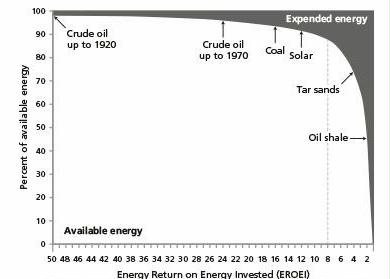Preface. This is just a small sampling of what Bardi thinks might happen post fossil fuels, mostly shortened and reworded.
Here are 7 other posts from this great book:
- Mining: Waste, Pollution, Destruction
- Ugo Bardi predictions of the future
- Minerals and War
- Minerals: Natural gas
- Minerals: Coal
- Mineral: Soil
- Peak Uranium
***
Bardi, Ugo. 2014. Extracted: How the Quest for Mineral Wealth Is Plundering the Planet. Chelsea Green Publishing.

Figure 1. The average EROEI required to run industrial society as we know it is around 8 to 10. Prieto and Hall (2013) found the EROI of solar to be 2.4 in “Spain’s Photovoltaic Revolution. The Energy Return on Investment” and Ferroni and Hopkirk in 2016 to be NEGATIVE .85 in journal “Energy Policy” on May 8
NATURAL GAS. As figure 1 shows, the average EROEI required to run industrial society as we know it is around 8 to 10. Shale gas and coal seam gas are both at, or below, that level if their full costs are accounted for, as are shale oil and tar sands. Thus fracking, in energy terms, will not provide a source on which to develop sustainable global society.
The problem is that storing natural gas requires heavy, expensive pressurized vessels, and transporting it requires complex and expensive infrastructure. On land, gas is transported through a network of pipelines. To travel by sea, gas must undergo cryogenic liquefaction to obtain a sufficiently high-energy-density liquid (liquefied natural gas, or LNG) for transportation in special refrigerated tankers. These methods are far from being satisfactory: pipelines cannot cross oceans, and cryogenic transportation is expensive. So gas remains mainly a regional resource, and it makes little sense to speak of a global production peak for gas in the same way we would for oil. But local gas peaks are possible. Several have been observed, such as the 1971 peak in the United States. However, in recent times the development of technologies to extract gas locked in shale deposits (“shale gas”) has prompted a return to high levels of gas production, especially in the United States. Because of this achievement, some have been speaking of a new era of prosperity based on shale gas. Most likely that is an exaggeration.
Fracking, or more accurately, hydraulic fracturing, is the process of opening up fractures in tight subterranean geological formations by injecting fluid at high pressure. Fracking was initially developed by the oil and gas industry in the late 1940s and has since been widely applied. Today over 50% of conventional oil and gas wells around the world are fracked.
Conventional oil and gas reservoirs are primarily sandstone or limestone with relatively high porosity and permeability. Fracking in this context is used to improve what are already fairly high flow rates. The process requires relatively small amounts of energy, fluid, and other materials. Non-conventional oil and gas resources, on the other hand, are contained within reservoirs such as shale beds or coal seams, which have much lower porosity and permeability. In both shale and coal seam fracking, the process injects fracturing fluid under high pressure to create the fractures and carry proppant material into the formation to keep the fractures open. In contrast to conventional reservoirs, the tightness of non-conventional reservoirs means that high volumes of fluid injection are required to be successful.
Unlike conventional oil and gas wells, shale beds and coal seams extend over wide areas. These reservoirs lack uniform oil and gas quality and content, so developers will try to access the “sweet spots” first. Typically the quality of the reservoir then deteriorates over time.
However, the greatest production challenge lies in the fact that shale and coal seam gas wells exhibit a “shooting star” production profile. Once fracking has been carried out, production rises rapidly to a peak, but it then declines rapidly, too, often by 80 to 95% over the first three years, as the oil or gas around the fractured area is exhausted. As a result the countryside has to be peppered with wells to maintain the production required to provide a return on investment, often several thousand wells in a single shale play.

One Response to Minerals: Natural gas from Ugo Bardi’s “Extracted”